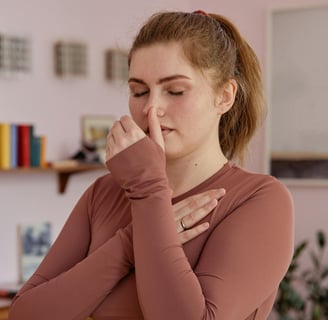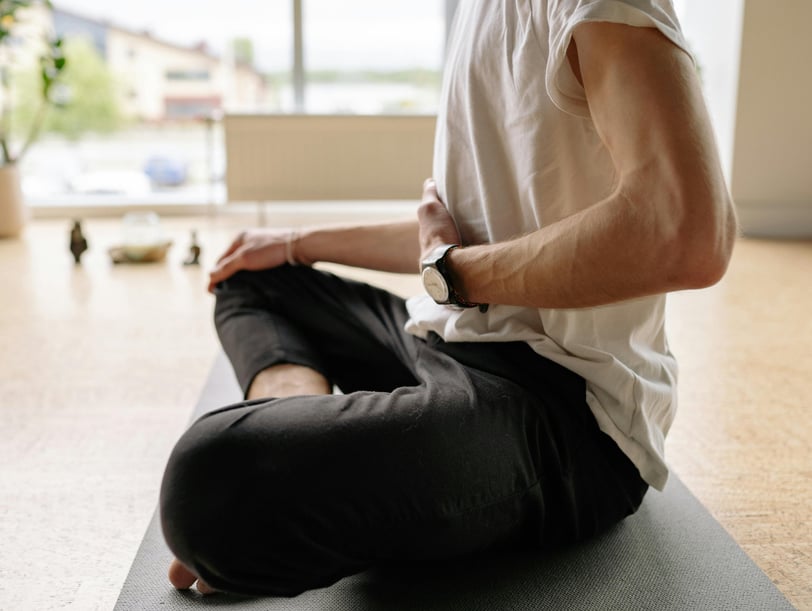7 Mindful Breathing Exercises to Instantly Reduce Stress
Discover 7 scientifically-backed mindful breathing exercises to reduce stress instantly. Learn easy techniques for calm, focus, and relaxation to enhance your well-being daily.
MINDFULNESS


In today’s fast-paced world, stress affects nearly every part of our lives, impacting our well-being, productivity, and even our relationships. Studies show that over 70% of adults experience stress or anxiety daily, and finding effective, accessible ways to reduce stress has never been more crucial (APA). Mindful breathing exercises offer a powerful, scientifically-backed method for alleviating stress, promoting calm, and enhancing overall well-being. In this article, we’ll explore seven highly effective breathing techniques you can incorporate into your daily routine, along with trending wellness products for 2024-2025 to complement your mindfulness practice.
Why Mindful Breathing?
Mindful breathing isn't just about taking deep breaths; it’s about cultivating present-moment awareness and aligning the mind and body. When practiced regularly, mindful breathing can help reduce cortisol levels, improve focus, and enhance emotional resilience. Let’s dive into each of these seven techniques, including research-backed benefits, practical guidance, and complementary tools to elevate your experience.


1. Deep Diaphragmatic Breathing
Deep diaphragmatic breathing, also known as belly breathing, helps engage the diaphragm to allow more oxygen into the lungs. This type of breathing has been shown to reduce cortisol, the body’s stress hormone, while increasing oxygen flow to the brain, which enhances mental clarity and relaxation.
How to Practice:
Find a comfortable seated or lying position.
Place one hand on your chest and the other on your abdomen.
Inhale deeply through your nose, feeling your abdomen rise as the diaphragm fills with air.
Slowly exhale through your mouth, noticing your abdomen fall.
Continue for 5-10 minutes.
Why It Works: Diaphragmatic breathing reduces blood pressure and stimulates the vagus nerve, shifting the body from the "fight-or-flight" mode to a "rest-and-digest" state. Research shows that practicing this breathing technique regularly can significantly improve heart rate variability, a key indicator of stress resilience (Khamsuk et al., 2021).
Pro tip: To deepen your practice, consider using a weighted blanket to enhance grounding during belly breathing. Weighted blankets provide gentle pressure that can mimic a therapeutic hug, making it easier to relax and connect with each breath.
2. Box Breathing (4-4-4-4)
Box breathing or square breathing is a technique used by Navy SEALs to stay calm under pressure. It involves inhaling, holding, exhaling, and pausing in equal counts, which helps balance the autonomic nervous system.
How to Practice:
Inhale deeply through your nose for 4 seconds.
Hold your breath for 4 seconds.
Exhale slowly through your mouth for 4 seconds.
Pause and hold your breath again for 4 seconds.
Repeat for 5-10 cycles.
Why It Works: This method reduces the sympathetic nervous response, lowering heart rate and promoting relaxation. Studies show that box breathing also enhances mental clarity and helps with decision-making under stress, making it ideal for a quick reset during a busy day (Lauria et al., 2017).
Pro Tip: Try using a biofeedback device to monitor your heart rate and breathing rhythm while practicing box breathing. This can help track improvements in real-time, adding an interactive element to your breathing practice.


3. Alternate Nostril Breathing (Nadi Shodhana)
Alternate nostril breathing, or Nadi Shodhana, is a traditional yogic technique that balances the left and right hemispheres of the brain, creating mental clarity and inner calm.
How to Practice:
Sit comfortably and close your eyes.
Close your right nostril with your thumb and inhale through the left nostril.
Close your left nostril with your ring finger, release your thumb, and exhale through the right nostril.
Inhale through the right nostril, close it, and exhale through the left.
Continue alternating for 5-10 minutes.
Why It Works: This exercise improves lung function and reduces anxiety by bringing the mind into a focused rhythm.
Pro tip: Use essential oils like lavender or eucalyptus while practicing to enhance relaxation and create a calming environment.
4. 4-7-8 Breathing Technique
The 4-7-8 breathing technique, developed by Dr. Andrew Weil, is designed to calm the mind and prepare the body for sleep, making it ideal for managing anxiety or winding down at night.
How to Practice:
Sit or lie comfortably with your back straight.
Place the tip of your tongue on the roof of your mouth.
Inhale quietly through your nose for 4 seconds.
Hold your breath for 7 seconds.
Exhale completely through your mouth for 8 seconds, making a whooshing sound.
Repeat 4 cycles or until you feel relaxed.
Why It Works: By slowing down your breathing, this technique slows the heart rate and engages the parasympathetic nervous system. It’s a natural way to calm anxiety, promote sleep, and reduce stress. Studies suggest it can even improve sleep quality when practiced regularly (Vierra et al., 2022).
Pro tip: To maximize relaxation, consider pairing this technique with a sleep mask infused with lavender for a truly restful experience.


5. Resonant Breathing (Coherent Breathing)
Resonant breathing, or coherent breathing, involves a steady rhythm of breathing at about five breaths per minute, which brings the body’s systems into alignment.
How to Practice:
Inhale slowly through your nose for a count of 5.
Exhale slowly through your nose for a count of 5.
Continue breathing at this pace for 10-20 minutes.
Why It Works: Slower breathing rates have been linked to better heart rate variability (HRV), a measure of the body’s resilience to stress.
Pro tip: For a deeper experience, try this technique with ambient soundscapes or calming background music.
6. Guided Visualization Breathing
Guided visualization breathing combines deep breathing with mental imagery. Visualization helps shift focus away from stress and enhances the relaxation response.
How to Practice:
Sit or lie in a comfortable, quiet space.
Close your eyes and begin breathing slowly.
Visualize a calming image, like a peaceful forest, a serene beach, or floating on a cloud.
As you exhale, imagine any stress leaving your body.
Continue for 5-10 minutes, immersing yourself in the imagery.
Why It Works: Guided visualization taps into the brain’s relaxation pathways, helping you manage stress while grounding your focus. Visualization techniques are widely used in sports and therapy for their effectiveness in reducing performance anxiety.
Pro tip: Pair this practice with a sound machine featuring nature sounds to enhance the imagery and create an immersive experience.


7. Breath Counting Meditation
Breath counting meditation is a simple mindfulness technique that involves counting each breath, enhancing focus and bringing awareness to the present moment.
How to Practice:
Sit comfortably with your back straight.
Close your eyes and take a few deep breaths.
Breathe naturally and count “one” to yourself as you exhale.
On the next exhale, count “two,” continuing until you reach “five.”
After five, start over at one. If your mind wanders, gently return to the breath and the counting.
Practice for 10-15 minutes.
Why It Works: This technique helps improve concentration, reduce mental chatter, and cultivate a calm, present state. Breath counting is an ideal exercise for beginners and can be practiced anywhere, anytime.


Complementary Wellness Tools for Enhanced Relaxation
Adding mindfulness-supportive tools can enhance the effectiveness of these techniques. Here are a few trending wellness products for 2024-2025:
Aromatherapy Diffusers: Add essential oils to heighten relaxation during breathing exercises.
Biofeedback Devices: Track heart rate and breathing, helping you stay mindful and see improvements in real-time.
Weighted Blankets: Perfect for grounding and adding a sense of comfort during mindful breathing practices.
For more on sustainable and wellness-centered products, explore our guide on Top 5 Affordable Eco-Friendly Products Everyone Can Afford for mindful shopping inspiration.
Key Takeaways
Mindful breathing exercises, such as 4-7-8 breathing and box breathing, can help reduce stress, promote calm, and improve sleep.
Pairing these techniques with wellness products—like aromatherapy diffusers or weighted blankets—can amplify the calming effects.
Practicing daily, even if only for a few minutes, can bring lasting benefits to your physical and mental well-being.
Q&As
How often should I practice a breathing technique for optimal results?
For optimal results, aim to practice any of the above mentioned breathing techniques daily, even if just for a few minutes. Consistent practice can help reinforce the positive effects on your mental and physical well-being, making it easier to manage stress over time.
Can breathing techniques help with sleep issues?
Yes, breathing exercises, particularly techniques like the 4-7-8 method, can significantly improve sleep quality. They calm the mind and body, making it easier to fall asleep and stay asleep, especially when practiced before bedtime.
What is the primary benefit of mindful breathing?
The primary benefit of mindful breathing is its ability to reduce stress and anxiety while promoting a sense of calm. It helps lower cortisol levels, enhances emotional resilience, and improves focus, making it an effective tool for managing daily stressors.
Are there any risks associated with breathing exercises?
Breathing exercises are generally safe for most people. However, individuals with respiratory conditions or anxiety disorders should consult a healthcare professional before starting any new breathing practice to ensure it’s suitable for their specific needs.
What should I do if I feel lightheaded while practicing breathing techniques?
If you feel lightheaded during breathing exercises, it's essential to stop and return to normal breathing. Lightheadedness can occur if you’re holding your breath too long or breathing too rapidly. Always listen to your body and adjust your practice as needed.
How can I integrate the breathing techniques into a busy schedule?
You can easily integrate these breathing techniques into a busy schedule by practicing for just a few minutes throughout the day—such as during a lunch break, while commuting, or before bed. Even short sessions can be beneficial for stress relief and mindfulness.










